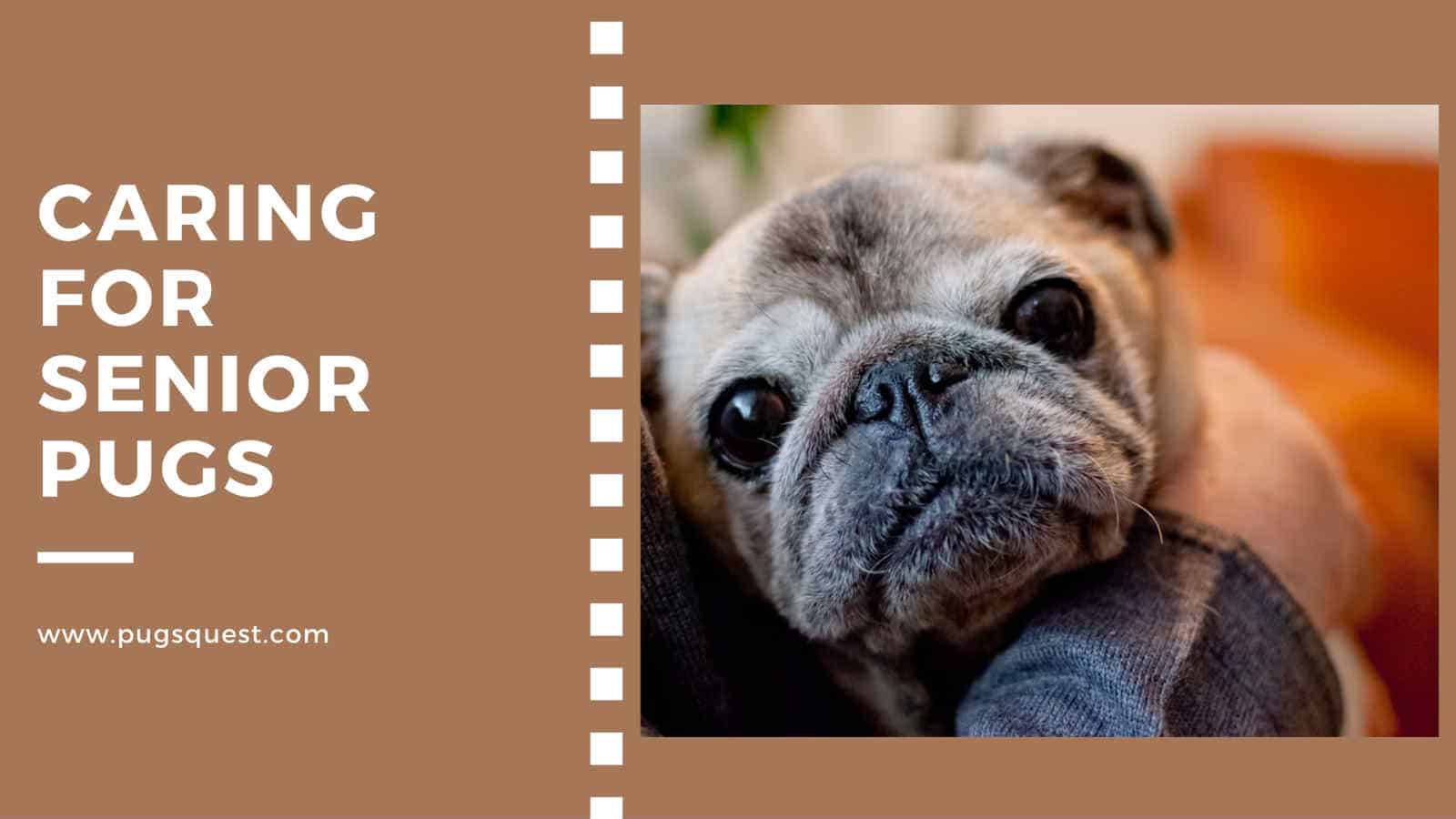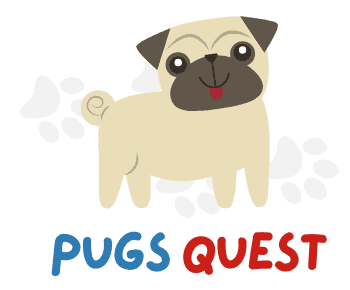
We’re here to clear any doubts you might have about caring for senior Pugs.
In this article, we’ll discuss some common signs of aging, health concerns, and care tips to keep your Pug healthy and happy throughout their golden years.
When Does My Pug Become A Senior?
Pugs enter senior citizenship at 9 year old.
In fact, it is only during the first 12 months of life that Pugs are considered puppies. That’s because toy breeds mature faster than larger breeds.
By their second year, your Pug has already entered adulthood and by their ninth they are already becoming senior citizens.
But remember, Pugs can live very long lives of up to 15 years. That means it’s possible that your pooch will spend 5 or 6 years of their life as a senior.
We want to help you help your Pug live out their retirement in style. By looking for signs of aging early, it will be easier to keep your pal in tip-top shape.
Signs To Look Out For in An Aging Pug
There are some signs to look out for as your Pug approaches a more mature age. It’s normal to start noticing some physical and behavioral changes in your dog. We recommend visiting your vet approximately once every six months or so for an all round check-up and once over.
We know it can be difficult to identify the difference between normal aging and more worrying symptoms. But don’t worry. We’re going to identify some common signs of aging as well as clinical indications that your pooch needs to visit their vet.
1. Common physical changes
- Thinning and/or greying coat
- Loose teeth that may fall out
- Long nails from reduced exercise
- Poor hearing and eyesight
2. Common behavioral changes
- Sleeping more and exercising less
- Becoming quieter and less playful
- Increased attachment to their owner
- Separation anxiety and increased barking
- Uncharacteristic aggressions due to discomfort
- Increased confusion (eg. walking in circles)
- Elimination accidents
Senior Pugs Health: When To Visit Your Vet
Just like us humans, Pugs are more likely to develop health issues as they get older.
Common health problems include obesity, incontinence, arthritis, periodontal disease, cataracts/ glaucoma, cardiovascular disease, kidney disease, cancers, and hypothyroidism.
The best way to monitor your older dog’s health is to schedule them in for a regular geriatric screening. A good geriatric screening will test for signs of aging and illness with physical examinations, blood samples and other specialized tests.
Geriatric screening tests for organ function, anemia, and heart murmurs. This is one of the most effective ways to catch illness early on and prevent more serious consequences.
Geraitric screening is highly effective but not comprehensive.
Blood samples and geriatric testing are unable to detect gastrointestinal, musculoskeletal, neurological or cardiovascular abnormalities.
That’s why we recommend owners look out for signs of potential illness themselves. These could include:
- Sudden or unexplained weight loss
- Serious loss of appetite
- Increased appetite or urination
- Constipation, diarrhea or vomiting
- Tiring very quickly
- Excessive coughing or panting
- Difficulty getting up from a seated position
If you notice one or more of these symptoms visit your vet immediately. These are signs of more serious illnesses that need professional, medical attention.
How To Care For An Older Pug
Old age doesn’t have to be all doom and gloom. There are lots of ways that you can help your furry friend live out their senior years healthily and happily. By offering them lots of companionship and TLC, your pooch will remain as comfortable as possible.
So what can we do to make life better for our old-age Pugs?
1. Diet
An older dog has very different nutritional requirements to a puppy. Reduced activity levels mean they’ll need fewer calories than their younger self. Due to their slowing metabolisms, failing to alter a senior Pug’s diet is a recipe for obesity.
In general, seniors need a diet high in fibre and low in calories. This will improve gastrointestinal health and stave off obesity. We recommend seeking the advice of your vet.
Together you’ll be able to work out an ideal diet plan for your senior Pug based on any pre-existing health needs.
With the approval of your vet there are plenty of things you can do at home to improve your Pug’s diet, from senior kibble to supplements. Let’s take a look.
- Dog food options
As your dog gets older transition them on to the senior variety of their favourite food brand. These will contain a unique combination of vitamins and minerals suited to veteran Pugs. Stick to treats that are low in sodium and low in fat and make sure to offer plenty of water.
- Food preparation
Elderly pugs might lose their appetite. To make food more appealing (and easier to eat) try warming it up. Aim for a soft consistency and avoid artificial or hard treats that could damage older teeth. Frozen fruit is a great example of a nutritious and hydrating treat.
- Supplements
Ask your vet to recommend some supplements, especially if your senior Pug is experiencing joint pain. Typical supplements include Glycerin for eye health, Bromelain for digestion, and Vitamin B-12 to support energy and metabolism.
2. Exercise
Senior Pugs still need exercise to remain healthy. Exercise prevents obesity and keeps Pugs mentally stimulated. But make sure you change up their routine. Each Pug is different so be observant and make sure your Pug isn’t experiencing overexertion.
Avoid exercising your Pug on a full stomach. Aim for two, short walks of about 20 minutes twice a day before mealtimes. Other forms of exercise include fetch, walking up and down the stairs, ramps, and playtime. Remember even young Pugs don’t need strenuous exercise.
3. Mobility
As your Pug gets older they will start to crave comfort. It’s likely that your veteran Pug will start experiencing reduced mobility.
Sore joints and stiffness make life that bit harder for seniors. But there are things we can do to help our precious pets.
There are lots of products on the market to make life that little bit more comfortable.
- Orthopedic mattresses for skeletal alignment
- Non-slip mats to prevent muscle strain
- Pee-pads for incontinence
- Cooling mats for temperature regulation
- Dog stairs to help Pugs reach the sofa
4. Hygiene
Teeth, hair, skin, and nails. That’s the name of the game when it comes to Pug hygiene. Brushing your Pug’s teeth regularly is good practice even with younger pups.
- Dental
Dental hygiene prevents gum disease by reducing bacterial buildup and painful inflammation of the gums. Serious cases of dental disease can even lead to life threatening organ damage.
To keep your Pug’s mouth healthy don’t wait until they’re geriatric. Brush their teeth each day and schedule regular veterinary brushing. Offer your Pug dental chews but look out for signs of painful gums that may need veterinary attention.
- Baths
Bathing your Pug removes excess oils and moisturizes their skin. Make sure you’re using warm water to keep your older Pug comfortable throughout their bath.
This is also a great time to give them the once over and check for any unexpected lumps or bumps that might need further veterinary attention.
- Grooming
Giving your Pug a daily grooming session prevents fleas and is a bonding experience for you and your pet. Your senior Pug will love the attention.
As your Pug gets older reduced exercise means their nails don’t get worn down as quickly as they used to. You’ll need to trim their nails more frequently in order to keep them comfortable. At least once every three weeks is advisable.
Senior Pugs FAQ
1. Will I have to get my senior Pug put down?
Not necessarily. Some dogs live out their old age in comfort. However, if your Pug shows signs of serious discomfort or suffering there may come a time when euthanasia is the most ethical option. This is never an easy decision to make and we advise having a serious conversation with a trusted vet who can lay out all the options for you.
2. Should I neuter/ spay my senior dog?
Spaying or neutering a senior Pug is something to discuss with your vet. The benefits include decreased risk of cancer (especially when done in puppyhood) but the risks for older dogs are quite high. Older dogs are less resilient to anesthesia so any surgery is inadvisable unless absolutely necessary.
Pug Retirement
Your Pug has reached retirement. Caring for senior Pugs is a time for lots of cuddles, love and care. Your senior Pug will need a bit of extra help, but armed with the right knowledge, it’s perfectly possible to keep your pooch healthy and happy as they grow old.
Check out this senior Pug’s day in a live video:
